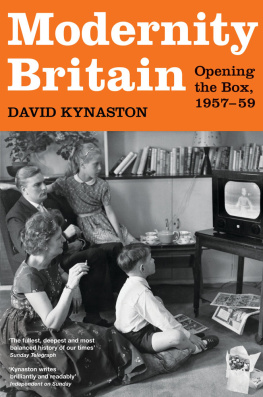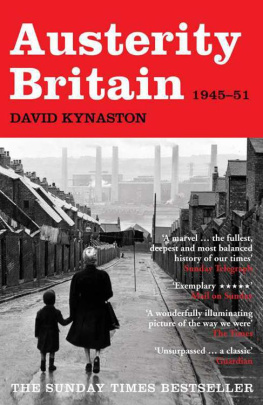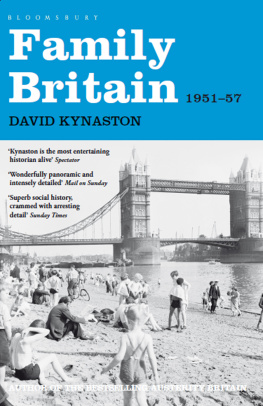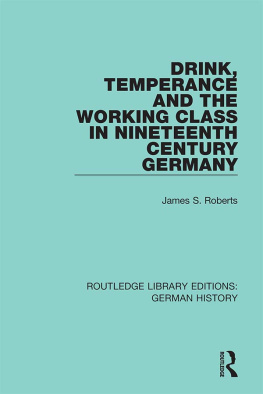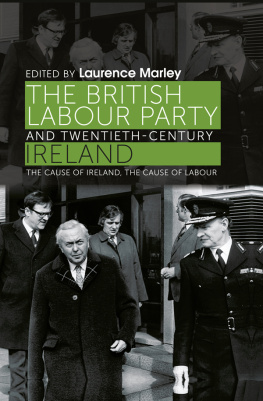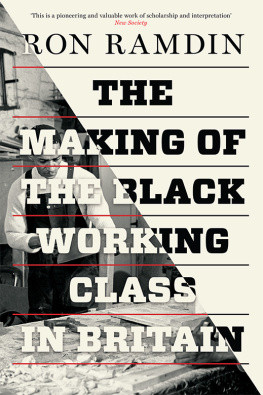ROUTLEDGE LIBRARY EDITIONS:
THE LABOUR MOVEMENT
Volume 23
KING LABOUR
KING LABOUR
The British Working Class,
18501914
DAVID KYNASTON
First published in 1976 by George Allen & Unwin Ltd
This edition first published in 2019
by Routledge
2 Park Square, Milton Park, Abingdon, Oxon OX14 4RN
and by Routledge
711 Third Avenue, New York, NY 10017
Routledge is an imprint of the Taylor & Francis Group, an informa business
1976 David Kynaston
All rights reserved. No part of this book may be reprinted or reproduced or utilised in any form or by any electronic, mechanical, or other means, now known or hereafter invented, including photocopying and recording, or in any information storage or retrieval system, without permission in writing from the publishers.
Trademark notice: Product or corporate names may be trademarks or registered trademarks, and are used only for identification and explanation without intent to infringe.
British Library Cataloguing in Publication Data
A catalogue record for this book is available from the British Library
ISBN: 978-1-138-32435-0 (Set)
ISBN: 978-0-429-43443-3 (Set) (ebk)
ISBN: 978-1-138-35205-6 (Volume 23) (hbk)
ISBN: 978-0-429-43484-6 (Volume 23) (ebk)
Publishers Note
The publisher has gone to great lengths to ensure the quality of this reprint but points out that some imperfections in the original copies may be apparent.
Disclaimer
The publisher has made every effort to trace copyright holders and would welcome correspondence from those they have been unable to trace.
KING LABOUR
The British Working Class
18501914
David Kynaston
London
George Allen & Unwin Ltd
Ruskin House Museum Street
Contents
First published in 1976
This book is copyright under the Berne Convention. All rights are reserved. Apart from any fair dealing for the purpose of private study, research, criticism or review, as permitted under the Copyright Act, 1956, no part of this publication may be reproduced, stored in a retrieval system, or transmitted, in any form or by any means, electronic, electrical, chemical, mechanical, optical, photocopying, recording or otherwise, without the prior permission os the copyright owner. Enquiries should be addressed to the publishers.
George Allen & Unwin (Publishers) Ltd. 1976
ISBN 0 04 942146 8 hardback
0 04 942147 6 paperback
Printed in Great Britain
in 10/11pt. Plantin type
by The Devonshire Press Ltd.
Barton Road, Torquay
In his already notorious New Statesman article of May 1975, A Brotherhood of National Misery, Paul Johnson described the wage-pulling trade unionists of the first half of the 1970s as dazed and bewildered, like medieval peasants who have burnt down the lords manor but have no idea what to do next. Much has happened since 1914, but in a very real sense, as Johnson himself suggests, the modern incomprehension is a direct result of the grittily defensive role which Labour out of necessity evolved for itself during the course of the nineteenth century. The manifold forms of social and economic control, the political retreat after Chartism, the continuing seduction of Gladstonian ethicalism for the influential minority, the alternative forms of inward burrowing for the passive majority all these alone meant that a grasp of Marxian totalities, the ability to cope with a burnt-down manor, almost entirely by-passed the British working class during this period. The object of the book is to study this process in action and in so doing add the worms eye perspective, the root of the modern bewilderment, to the half-truth embodied in the horny old phrase the rise of Labour.
For my material I am largely dependent on the researches of others. The references show the extent of my debt. The coverage is in no way intended to be comprehensive either in a chronological or a region-by-region sense, though I do give certain phases (for example 186575) more detailed treatment as central working examples of particularly significant issues and attitudes. The book is concerned primarily with the second half of the nineteenth century, and it is to that time span that the middle background chapters are related, but at the risk of a certain imbalance I have added a short postscript chapter in order to take the political narrative up to the formative event of the Great War.
My thanks to Keith Harling at the London Library and Miss Leslie at Senate House for bibliographical help; to Rosie Elgar for typing help; and to Jill Nicholls, John Wakefield and Dave Wilson for conversational help. The book is dedicated to Zvia.
King Labour
The wizard, King Labour, walked over the land,
And the spade for a sceptre he bore;
And each step he took left an Eden behind,
While the desert untamed frowned before.
He levelled huge mountains, and blasted the rocks,
Where for ages vast treasures lay hid;
And shewed Heaven the coffer where Earth stored her wealth,
And laughed loud as he shattered the lid.
J. B. LENO
Chartists, what is your duty? It is to organise. I tell you we are on the very verge of triumph.
The Government are without funds their expenditure is increasing the middle class mistrust them the working class despise them
These hopeful words, addressed by Ernest Jones to fellow-Chartists soon after the mass meeting held on Kennington Common on 10 April 1848, proved sadly misplaced. Jones himself, along with five other leading London Chartists, was shortly to receive a sentence of two years imprisonment on the grounds of seditious behaviour and unlawful assembly; and by the time that the four survivors came out of Millbank prison in July 1850, the working class, perhaps mindful of the pitfalls of violence so often associated with the Chartist movement, had begun to apply itself to the less adventurous task of making progress strictly within the existing social and political framework. The Great Exhibition, held in Hyde Park the following year and visited by thousands on cheap railway excursions, was symbol of this self-proclaimed era of industrious harmony. Class conflict did not suddenly become a thing of the past, but undoubtedly there took place during the third quarter of the century a change of atmosphere so fundamental that it gave the British labour movement a reformist character of apparent permanence. The Second Reform Act of 1867, enfranchising about a million of the urban working class, provided formal admission for a large part of this movement into the body politic. Yet it is sometimes forgotten, in emphasising the skilful absorption and tactical nuances of Disraelis legislation, that 1867 did represent, and was seen to represent at the time, a substantial victory for what one may call the disinherited of the Industrial Revolution. The behaviour of the railway-men is instructive in this respect. In 1848 many of them had been sworn in as special constables to defend London against the Chartists. Then during the next two decades, under the iron control of the companies, barely more than a fortnight of strikes occurred on the railway system of the entire country. But in the Reform crisis itself, many enginemen and various traffic grades, all in uniform, gave their support to the Reform Leagues impressive demonstration held on 11 February 1867. They were permitted to do so because their employers, while perceiving the mens determination to make this stand, were also aware that the redress of a specific grievance, and not revolution, was the motive involved. Reformism yes, but an insistent reformism: such was the controlling theme of the years which followed the sudden Chartist collapse.


